We would like to tell you about two new technology development initiatives recently approved by our Advisory Council. These programs are part of an ongoing effort that we’ve previously described to facilitate early stage, investigator-initiated work to create or improve tools for biomedical research.
Developing and providing access to technologies that enable biomedical research is a high priority for NIGMS, as expressed in our 2015 strategic plan. Historically, support for technology development has generally been coupled to using the technology to answer a biomedical research question. Although in the later stages of technology development this coupling is often useful, in the early stages it can hinder exploration of innovative ideas that could ultimately have a big impact on research.
We think the two initiatives briefly described below will stimulate early stage technology research and development by allowing scientists to focus on making the technology work before they begin to apply those tools to biomedical research questions.
Continue reading “New NIGMS Initiatives for Supporting Technology Development”



